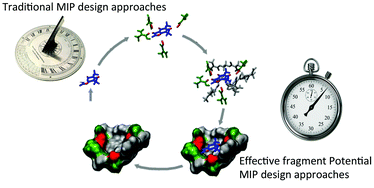Effective fragment potential (EFP) molecular modeling approaches have been applied for the first time to the rational design of molecularly imprinted polymers for the group recognition of selected polychlorinated biphenyls (PCBs). EFP calculations were benchmarked using the S22 compound test set and returned energies within 1 kcal mol−1 of the reported gold standard CCSD(T) approach, but without the computational cost. EFP allowed the rapid identification of trimethylstyrene (TMS) and pentafluorostyrene (PFS) as the functional monomers of choice for the templates (T) 1,2,3,4,5-pentachlorobenzene (4) and for 1,2,3-trichlorobenzne (5) respectively. Ethyleneglycol dimethacrylate was the cross linker (CL) of choice. Using a 1 : 2 : 10 (T : FM : CL) ratio for 4 (TMS as the FM; MIP4-TMS4-TMS4-TMS) gave imprinting factors (IF) of 2.1; and a 15 : 6 : 29 ratio for 5 gave an IF of 3.66 (PFS as FM; MIP5-PFS5-PFS). MIP4-TMS4-TMS4-TMS and MIP5-PFS5-PFS showed low levels recognition for non-chlorinated templates with IF values ranging of 1.05, 1.17 and 1.13, 1.54 for toluene (14) and 2,6-dimethylaniline (12) respectively. Higher levels of recognition were observed for the chlorinated analogues 1,3,5-trichlorobenzene (11) and 2,4,6-trichloroaniline (12) with IF values of 1.20, 1.64 and 1.89, 2.66 for MIP4-TMS4-TMS4-TMS and MIP5-PFS5-PFS respectively suggesting these MIPs were suitable for fragment imprinting of PCBs. Fragment imprinting of 2,2′,3,5′-tetrachlorobiphenyl (15), 2,3,3′,4,4′-pentachlorobiphenyl (16) and 2,2′,3,3′,4,5,6′-heptachlorobiphenyl (17) with MIP4-TMS4-TMS4-TMS gave IF values of 1.38, 1.38 and 1.41 respectively. MIP5-PFS5-PFS performed significantly better with IF values of 6.57, 3.46 and 5.80 for 15–17 respectively. Moreover MIP5-PFS5-PFS displayed a higher binding capacity than MIP4-TMS4-TMS4-TMS and was less susceptible to non-specific binding influences.


 Please wait while we load your content...
Please wait while we load your content...